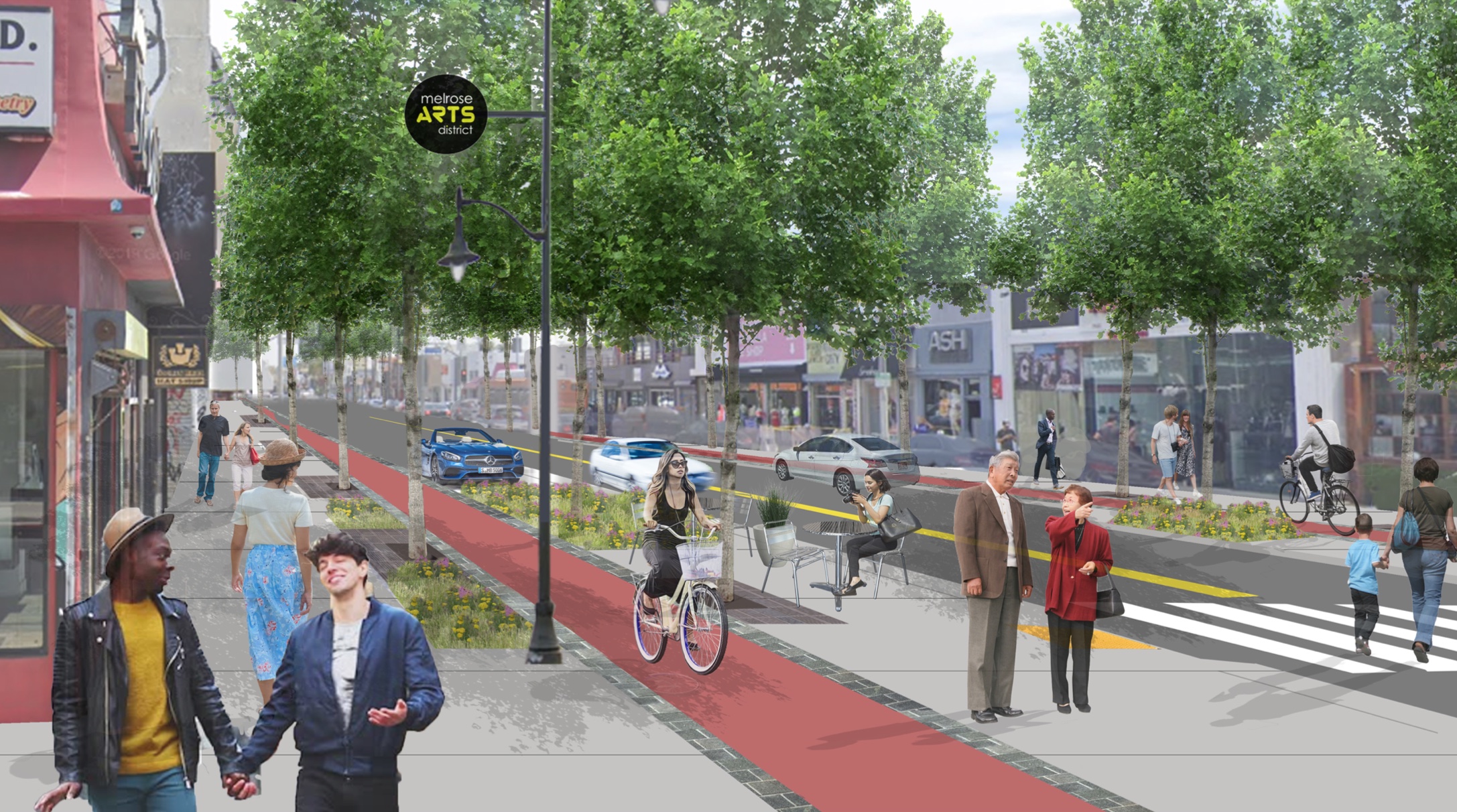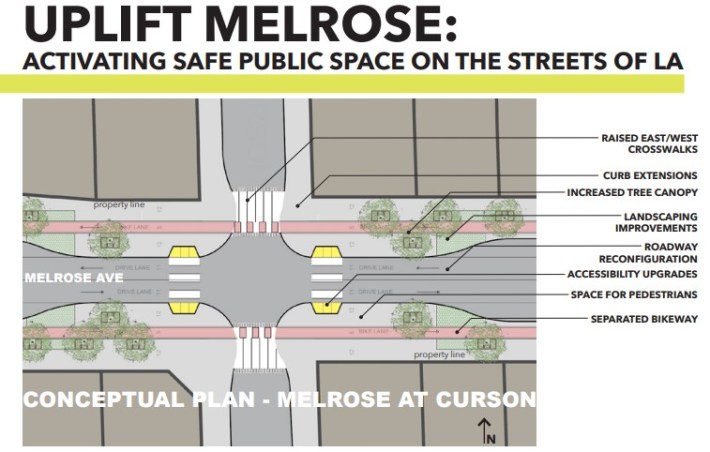L.A. City Councilmember Paul Koretz has effectively killed Uplift Melrose, a plan to invest in making Melrose Avenue greener, safer, and more welcoming. Uplift Melrose was initiated by the Melrose Business Improvement District and enjoyed broad local support, including from the Mid-City West Community Council and the Greater Wilshire Neighborhood Council.
Yesterday, Koretz removed Uplift Melrose from the city's planned applications for state Active Transportation funding, cutting off the main potential funding source for bike/walk projects in California.
On Tuesday, in a "Dear Community" letter, Koretz announced that he did not support moving Uplift Melrose forward. From the letter:
I had doubts about whether the potential downsides were adequately considered, so I asked for more outreach to the public, so that there was a greater awareness of the project and what was being proposed. I instructed my staff to initiate a process for our own due diligence in researching the possible impacts. As more outreach was done, and discussions of positives and negatives have taken place, concerns have been expressed by many in the residential community.
I have done much soul searching, and even driven down Melrose one more time to try and envision the results.
Koretz states, "I don’t believe that [Uplift Melrose] will get anyone out of their cars, except for immediate neighbors on short trips who could walk or bicycle" and goes on to lean on "concerns... expressed by our public safety departments" that the proposed road diet would adversely impact emergency responders:
The bottleneck that the reduction of lanes would create, as well as the inability to ingress and egress at critical points along the way, are likely to greatly impede the ability of police vehicles, fire engines, and ambulances to respond in appropriate time.
...Additionally, the significant lane reduction would impact the ability to keep Melrose open should there be a requirement for an emergency response on Melrose. The presence of police and fire, whether it is an Engine Company or multiple police vehicles, would in all likelihood immediately close Melrose in both directions. Having received letters of great concern from both departments, as well as private conversations with leadership from these departments, I know their concerns are serious.
Koretz' office provided Streetsblog the "letters of great concern" from the police and fire departments. Streets L.A. provided Streetsblog with their response to LAFD concerns.
LAPD Wilshire Area Commanding Officer Shannon Paulson's August 25 email to Koretz staff states that Uplift Melrose "would undeniably have a direct impact on the ability of PD to respond along this (previously) primary accessway to emergency locations on this stretch of Melrose, as well as... emergencies in adjacent residential neighborhoods." She asserts that the proposed Melrose lane reduction would "undeniably" create "traffic congestion and delays" on Melrose and "this would also result in more north/south traffic in those nice residential streets north and south of Melrose" where she forecasts "more calls for unsafe speed... and a higher likelihood of vehicle vs pedestrian accidents, stop sign violations, more people feeling not as safe walking their dogs and pushing their strollers on those streets."
Then LAPD's Paulson goes on to broadly dismiss bike lanes all over Los Angeles:
I would also suggest a comprehensive study of the bike lanes. I have seen a lot of money and energy and planning go into some of these bike lanes in the City– which are fantastic for those who use them. But I think in many LA communities the use of these bike lanes have been exceptionally minimal (to almost zero) – this after surrendering very valuable vehicle traffic lanes to create them. I have also been part of conversations regarding their safety, as they design the lanes to be “two way” which results in some dangerous scenarios. I think immediately of the “two way” bike lane currently on Main Street downtown – where you have City Hall employees pulling out of that CH garage near Temple and they look right only as the traditional vehicle traffic on Main St is northbound, yet that bike lane along the curb is two -way. So you have a southbound bicycle coming along at 25 mph crossing them that the driver never see.
With partners like LAPD, it appears that L.A. City's Vision Zero program doesn't need any enemies. And L.A. cyclists are still waiting to see that "lot of money" go into bike lanes.
LAFD Director of Government Affairs Cheryl Getuiza's September 2 email to Koretz staff expresses several project concerns from LAFD's Fire & Prevention Bureau's Hydrants & Access Unit, including:
- "Curb extensions and bump-outs in the current design are placed at intersections creating pinch points for apparatus which will likely impact apparatus maneuverability"
- "Raised crosswalks will decrease [sic] LAFD response time"
- "Increased sidewalk width combined with bike lane installation may create a delay for conducting emergency operations or responding to medical emergencies (i.e. stopping bicycle traffic)"
- "Significant potential impact to response times based on the scope of the project (1.3-mile length) of a commonly used response route"
Koretz' staff received Streets L.A. Landscape Architect Alexander Caiozzo's response to all of the points raised by Getuiza. Caiozzo's September 3 email emphasizes that the Melrose design represents a "preliminary plan" and, when funding is secured, further refined designs will address all the specific Fire Department concerns.
Two specific concerns and responses are somewhat instructive:
- LAFD notes that the "raised crosswalks will decrease LAFD response time" (they presumably meant "worsen" or "increase" response time.) Streets L.A. responded noting that "raised crosswalks will only be installed across local/collector streets perpendicular to Melrose - and not on Melrose Ave" and that these smaller perpendicular streets "commonly feature speed humps" which perform similarly to raised crosswalks.
- LAFD notes that "increased sidewalk width combined with bike lane installation may create a delay for conducting emergency operations or responding to medical emergencies (i.e. stopping bicycle traffic)" which is somewhat difficult to understand. The Fire Department is apparently asserting that sidewalk bicycle traffic will cause response time delays? Perhaps that LAFD will waste time stopping cyclists to get them out of the way of fire vehicles that are crossing sidewalks? Perhaps they mean fire vehicles turning across crosswalks (though LAFD wrote "sidewalk")? Of course, it takes a fraction of a second for a bicyclist to move out of the way of a fire truck, something that cannot be said of cars. Streets L.A. responded that L.A. City already allows cyclists to legally ride on sidewalks here, and that the project would not change this.
Streets L.A.'s responded to all of LAFD's concerns, expressing can-do optimism - in the words of Streets L.A. spokesperson Martin Schlageter, "working with our partners at LAFD to ensure a project that meets everyone's needs."
Koretz doesn't mention Streets L.A. in his letter.
Do street safety projects actually adversely impact emergency response times? The concern is a heavy-rotation talking point among supporters of the car-centric status quo, but the actual situation is more complicated. Streets designed to be deadly take up a lot of fire and police time responding to L.A.'s epidemic of car crashes, many of which kill and maim Angelenos. Improving street design to make speeding and other deadly behavior less the norm would allow firefighters and police officers to spend less time responding to car crashes and instead focus on fires and crime. In the rest of North America, many fire departments are embracing safe street designs. In L.A. not yet.
Where did Koretz and the city's police and fire departments get these talking points?
One source is the "notorious Nimby" group Fix the City. In 2015, Fix the City filed a lawsuit to block L.A.’s multi-modal Mobility Plan, asserting that the city was “stealing” lanes from drivers, who do not “have the luxury of being able to ride to work on a bike or bus.” The lawsuit was settled by an agreement between L.A. City and Fix the City that mandates extensive outreach and analysis before safety improvements can be implemented. Fix the City then uses this agreement to kill safety projects.
The settlement requires the city to evaluate LAFD response times at the station level for all mobility projects of significant scale. If safety improvements degrade LAFD response times, then Fix the City boardmember Jim O'Sullivan waves the settlement around, badgers the city Transportation Department (LADOT) and City Council, and threatens further lawsuits.
Fix the City submitted public comment on the city's proposal to apply for funding for Uplift Melrose, stating:
I have direct knowledge that the [settlement-mandated] Outreach and Evaluation process was not abided by with [the] Melrose Avenue Active Transportation Project.
[Uplift Melrose] should be removed from the package and the rest of the package scrutinized to make sure none of the other items are in violation of the [settlement] agreement.
Instead of siding with businesses and neighborhood councils for a greener and more livable Melrose, Councilmember Koretz chose to stick with Fix the City, effectively killing the project before city departments and community could collaborate on a design that could balance the many needs in the community. Leadership in the fire and police departments repeated Fix the City talking points, conspiring to give Koretz cover.
Koretz calls himself a climate champion even though he has consistently failed to comprehend the link between automotive tailpipe emissions and global warming - despite the car-heavy transportation sector being California's largest source of greenhouse gas emissions. Koretz' failure on Uplift Melrose should not be surprising. He has consistently embraced more traffic congestion, more pollution, more emissions, and fewer viable alternatives to driving. Koretz was one of two councilmembers to vote against the city's Mobility Plan; his rationale was to quash planned bike lanes on Westwood Boulevard. He has also been against transit-oriented affordable housing along the Metro E (Expo) Line and heavily against e-scooters.
Paul Koretz is termed out of the city council, and running for controller. Will his anti-climate anti-green-mobility stances hurt him in pursuit of higher office?








